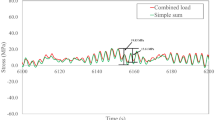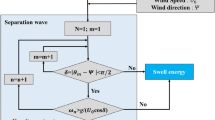Abstract
Wind farms are typically constructed in offshore areas using floating structures. However, such structures are difficult to maintain, sufficient fatigue life must be ensured during the design process. Therefore, techniques for determining the fatigue load on a floating structure in a marine environment and predicting its lifespan are required. This paper proposes a deterministic fatigue damage analysis method of semi-submersible platform for wind turbines using a hydrodynamic-structure interaction analysis. The process for calculating the fatigue load cycle consists of generating the waves in the time series using the JONSWAP spectrum from probabilistic wave scatter diagrams and decomposes them repeatedly into a number of individual regular waves. This process can simplify calculation of the fatigue load cycle by converting irregular dynamic wave load into a combination of static wave loads. The stress range for fatigue analysis is calculated through hydrodynamic structure interaction analysis. The stress ranges are applied to the S–N curves specified in the DNV-RP-C203 and cumulative fatigue damage is predicted using Miner’s rule. To detailed describe the proposed method, fatigue damage analysis was performed on the DeepCwind semi-submersible developed by the National Renewable Energy Laboratory based on the state of the western sea of Jeju Island, South Korea.















Similar content being viewed by others
Abbreviations
- \(H_{s}\) :
-
Significant height
- \(T_{p}\) :
-
Peak period
- \(g\) :
-
Gravitational acceleration
- \(\omega_{p}\) :
-
The peak frequency in rad/s
- \(\gamma\) :
-
The peak enhancement factor
- \(\alpha\) :
-
Constant that relates to the wind speed and the peak frequency of the wave spectrum
- \(N\) :
-
The number of harmonics
- \(\omega_{n}\) :
-
The nth angular frequency
- \(a_{n}\) :
-
The nth amplitude
- \(\phi_{n}\) :
-
The nth uniformly distributed phase angle [0,\(2\pi\)]
- \(\Delta \omega\) :
-
The angular frequency interval
- \(\Delta \sigma_{m,hotspot}\) :
-
Membrane stress
- \(\Delta \sigma_{b,hotspot}\) :
-
Bending stress
- \(N_{L\_i}\) :
-
iTh fatigue loading cycle
- \(N_{A\_i}\) :
-
iTh fatigue allowable cycle
- r:
-
Radius of the tubular member
- t:
-
Thickness of the tubular member
- D:
-
Cumulative fatigue damage
References
Hamilton, B. (2015). Global offshore wind market. In Wind shipping and Logistics Conference, Copenhagen, Denmark, March 12, 2015.
Campbell, M. (1999). The complexities of fatigue analysis for deepwater risers. In Proceedings of the deepwater pipeline conference, New Orleans, 1999.
Plaza, A. B. S. (2003). Fatigue assessment of offshore structures. Northchase Drive Houston, TX 77060 USA, 2003.
Gao, Z., & Moan, T. (2008). Frequency-domain fatigue analysis of wide-band stationary Gaussian processes using a trimodal spectral formulation. International Journal of Fatigue, 30(10), 1944–1955.
Junfeng, D., Huajun, L., Min, Z., & Shuqing, W. (2015). A novel hybrid frequency-time domain method for the fatigue damage assessment of offshore structures. Ocean Engineering, 98(1), 57–65.
Longuet-Higgins, M. S. (1983). On the joint distribution of wave periods and amplitudes in a random wave field. Proceedings of the Royal Society of London A Mathematical Physical and Engineering Sciences, 389(1797), 241–258.
Sheehan, J.M., et al. (2005). Characterisation of the wave environment in the fatigue analysis of flexible risers. In: 24th International Conference on Offshore Mechanics and Arctic Engineering (OMAE 05), pp 997–1006.
Bai, X., et al. (2016). Fatigue assessment for the floating collar of a fish cage using the deterministic method in waves. Aquacultural Engineering, 74, 131–142.
Bai, X., et al. (2018). Probabilistic analysis and fatigue life assessment of floating collar of fish cage due to random wave loads. Applied Ocean Research, 81, 93–105.
Jia, J. (2008). An efficient nonlinear dynamic approach for calculating wave induced fatigue damage of offshore structures and its industrial applications for lifetime extension. Applied Ocean Research, 30(3), 189–198.
Song, X., et al. (2016). An innovative block partition and equivalence method of the wave scatter diagram for offshore structural fatigue assessment. Applied Ocean Research, 60, 12–28.
Song, X., & Wang, S. (2019). A novel spectral moments equivalence based lumping block method for efficient estimation of offshore structural fatigue damage. International Journal of Fatigue, 118, 162–175.
de Sousa, F. J. M., et al. (2013) An alternative methodology to evaluate the fatigue life of risers based on regular waves. In ASME 2013 32nd International Conference on Ocean, Offshore and Arctic Engineering. American Society of Mechanical Engineers Digital Collection, 2013.
Lefebvre, S., & Collu, M. (2012). Preliminary design of a floating support structure for a 5MW offshore wind turbine. Ocean Engineering, 40, 15–26.
Zhao, Y., Yang, J., & He, Y. (2012). Preliminary design of a multi-column TLP foundation for a 5-MW offshore wind turbine. Energies, 5(10), 3874–3891.
Aubault, A., Cermelli, C., Roddier, D. (2009). WindFloat: A floating foundation for offshore wind turbines—Part III: Structural analysis. In ASME 2009 28th International Conference on Ocean, Offshore and Arctic Engineering. American Society of Mechanical Engineers, Vol. 1, No. OMAE2009-79232, pp. 213–220, 2009.
Roddier, D., Cermelli, C., Aubault, A., & Weinstein, A. (2010). WindFloat: A floating foundation for offshore wind turbines. Journal of Renewable and Sustainable Energy, 2(3), 033104.
Li, L., Cheng, Z., Yuan, Z., & Gao, Y. (2018). Short-term extreme response and fatigue damage of an integrated offshore renewable energy system. Renewable Energy, 126, 617–629.
Li, X., & Zhang, W. (2020). Long-term fatigue damage assessment for a floating offshore wind turbine under realistic environmental conditions. Renewable Energy, 159, 570–584.
Moghaddam, B. T., Hamedany, A. M., Taylor, J., Mehmanparast, A., Brennan, F., Davies, C. M., & Nikbin, K. (2020). Structural integrity assessment of floating offshore wind turbine support structures. Ocean Engineering, 208, 107487.
Shi, W., Kim, C. W., Chung, C. W., & Park, H. C. (2013). Dynamic modeling and analysis of a wind turbine drivetrain using the torsional dynamic model. International journal of precision engineering and manufacturing, 14(1), 153–159.
Shi, W., Park, H. C., Baek, J. H., Kim, C. W., Kim, Y. C., & Shin, H. K. (2012). Study on the marine growth effect on the dynamic response of offshore wind turbines. International Journal of Precision Engineering and Manufacturing, 13(7), 1167–1176.
Shi, W., Park, H. C., Chung, C. W., Shin, H. K., Kim, S. H., Lee, S. S., & Kim, C. W. (2015). Soil–structure interaction on the response of jacket-type offshore wind turbine. International Journal of Precision Engineering and Manufacturing-Green Technology, 2(2), 139–148.
Lee, K. H., Jun, S. O., Pak, K. H., Lee, D. H., Lee, K. W., & Park, J. P. (2010). Numerical optimization of site selection for offshore wind turbine installation using genetic algorithm. Current Applied Physics, 10(2), S302–S306.
Dong, W., Moan, T., & Gao, Z. (2011). Long-term fatigue analysis of multi-planar tubular joints for jacket-type offshore wind turbine in time domain. Engineering Structures, 33(6), 2002–2014.
Yeter, B., Garbatov, Y., & Soares, C. G. (2015). Fatigue damage assessment of fixed offshore wind turbine tripod support structures. Engineering Structures, 101(15), 518–528.
Veritas, D. N. (2010). Fatigue design of offshore steel structures. Offshore Standard DNV RP C203, 2010.
Veritas, D. N. (2004). Design of offshore wind turbine structures. Offshore Standard DNV-OS-J101, 2004.
Houmb, O. G., & Overvik, T. (1976). Parameterization of wave spectra and long term joint distribution of wave height and period. In Proceedings of 1st International Conference on Behavior of Offshore Structures (BOSS), pp. 144–167, 1976.
Veritas, D. N. (2013). Design of floating wind turbine structures. Offshore Standard DNV-OS-J103, 2013.
ANSYS, Inc. (2012). AQWA user manual. Canonsburg: ANSYS, Inc.
Robertson, A., Jonkman, J., Masciola, M., Song, H., Goupee, A., Coulling, A., & Luan, C. (2012). Definition of the semisubmersible floating system for phase II of OC4. NREL, Technical Report, 2012.
Luan, C., Gao, Z., & Moan, T. (2013). Modelling and analysis of a semi-submersible wind turbine with a central tower with emphasis on the brace system. In ASME 2013 32nd International Conference on Ocean, Offshore and Arctic Engineering. American Society of Mechanical Engineers, Vol. 8, No. OMAE2013-10408, p. V008T09A024, 2013.
Acknowledgements
This work was supported by the National Research Foundation of Korea (NRF) grant funded by the Korea government (MSIT) (2019R1A2C1090228) and the Technology Innovation Program (20012518) funded By the Ministry of Trade, Industry & Energy (MOTIE, Korea).
Author information
Authors and Affiliations
Corresponding author
Additional information
Publisher's Note
Springer Nature remains neutral with regard to jurisdictional claims in published maps and institutional affiliations.
Rights and permissions
About this article
Cite this article
Lee, DC., Na, Sk., Kim, S. et al. Deterministic Fatigue Damage Evaluation of Semi-submersible Platform for Wind Turbines Using Hydrodynamic-Structure Interaction Analysis. Int. J. of Precis. Eng. and Manuf.-Green Tech. 9, 1317–1328 (2022). https://doi.org/10.1007/s40684-021-00326-7
Received:
Revised:
Accepted:
Published:
Issue Date:
DOI: https://doi.org/10.1007/s40684-021-00326-7




